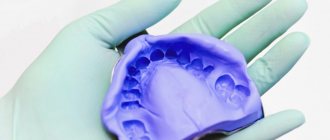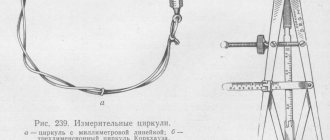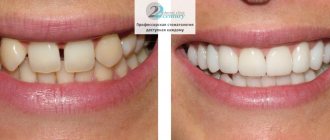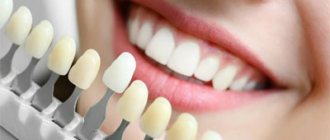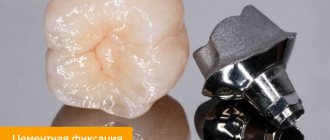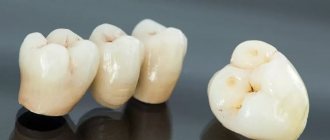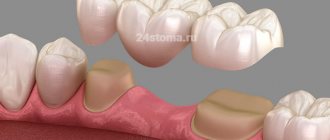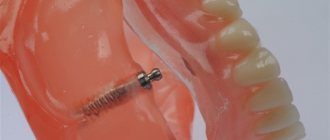Silicone impression material and mechanical manual mixing gun
An impression tray with perforations is coated with a thin layer of special adhesive. To carry out the manipulation you need: 1) a set of tools (mirror, tweezers, angled probe, smoothers of different sizes, a special shaped knife); 2) means for retraction (knitted rings or cotton threads).
Double impression technique.
As a rule, this procedure is carried out in two stages.
In the first of them, a basic dense paste (Ortosil, Zetaplus, ZM Express, Bisico, Speedex) mixed with a catalyst is applied to a release tray lubricated with adhesive and an impression is taken. At the same time, in order to create space for the corrective paste, the procedure is carried out before preparing the teeth, without removing the provisional (temporary) crowns or by first covering the impression material with a strip of thin polyethylene film. In this case, there will be some space for the clarifying (correcting) layer, which will facilitate obtaining a more accurate impression without excessive pressure on its individual areas.
Filling the tray with the main impression material (explanations in the text)
Preliminary impression of the upper jaw
After preparation, a pharmacomechanical expansion of the gingival groove (pocket) of the supporting teeth is carried out, a linen or cotton thread or a knitted ring is introduced there, pre-impregnated or ex tempore with solutions of a vasoconstrictor and an astringent.
Insertion of a retraction thread into the gingival grooves of prepared teeth: a - beginning; b- end of the procedure
Hollow cotton cylinders are used to dry (including stop bleeding from the gingival sulcus) the hard tissues of the tooth and fix the retraction thread when taking double impressions After inserting the retraction cord into the gingival sulcus, a cotton cylinder is placed into the prepared tooth. The dentition is then fused to provide a clean, dry, and open gingival sulcus. The cotton cylinder and retraction thread are removed immediately before taking the corrective impression. The first layer of the impression personalizes the standard tray with which it was produced. A layer of paste is cut off on it at the top of the roof of the palate and along the edges of the impression for its free reintroduction into the oral cavity. In addition, the interdental septa are removed to prevent compression of the interdental papillae. Finally, the outlet grooves are engraved from the tooth impressions to the top of the palatine vault, radially, to prevent elastic deformation of the impression.
Preparation of the first layer of double impression for applying the corrective mass
Then the first layer of the print is dried and filled with a low-viscosity clarifying paste (Xantopren, Oranwash, Thixoflex, Bisico, etc.).
Application of a low-viscosity corrective impression mass to obtain a clarifying impression
The threads are removed from the pockets, and the pockets themselves are dried with a stream of warm air. They can be filled with corrective paste using a special syringe with a curved cannula.
Filling gum pockets with corrective paste using a syringe with a curved cannula
You can take an impression without using a syringe by filling the impression with clarifying paste and reintroducing it into the oral cavity. After the corrective paste has hardened, the impression is removed from the patient’s mouth.
Double impression after removal from the patient's mouth
Obtaining a two-layer print
One of the main stages in the manufacture of solid-cast fixed dentures is taking an impression.
The requirements for impression materials and their properties to accurately depict the tissues of the prosthetic field are also increasing. Conventional single-layer impressions do not provide high accuracy, therefore, in the manufacture of metal-ceramic prostheses, two-layer (double) impressions are used. When obtaining such impressions, silicone materials are used. Silicone impression compound used for metal-ceramics consists of two (or more) materials of different consistency and is supplied in the following commercial forms:
— Separately stored catalyst paste and main paste.
— Basic paste and liquid (catalyst).
Depending on the consistency, silicone impression materials are divided into two types:
I. Material of liquid consistency.
II. Material of dough-like consistency.
Type I is used for the second (corrective) layer, and type II is used for the first (approximate) layer of a two-layer print.
The following silicone masses are produced by the domestic industry and foreign companies for obtaining two-layer impressions:
— sielast 03, sielast 0
5 (Ukraine),
— Dentaflex
(Slovakia),
— Optosil, Xantopren, Delicron
(Germany),
— Exaflex
(Japan), etc.
Two-layer impressions can be used in certain cases (large volume of work, deep gingival pocket, location of the ledge at the level of the gingival margin, etc.) when making porcelain crowns.
Two-layer impressions used in the manufacture of solid-cast fixed dentures require particularly accurate representation of marginal periodontal tissues, hard tooth tissues in the cervical zone, gingival margin and gingival groove (pocket). For this purpose, a special manipulation is performed - gum retraction, which consists in expanding the gingival groove for the subsequent introduction of impression material into it.
In the manufacture of fixed dentures, the gingival groove plays a significant role. Many issues related to the nature of the relationship between the tissues of the tooth in the cervical part and the gum are still controversial. In the specialized literature there is not even a single name for it - periodontal groove, gingival sulcus, gingival pocket, gingival crevice, etc. According to WHO recommendations in 1978, it was proposed to call this space the gingival groove. The question of the depth of this space is controversial. According to studies by various authors, the depth of the gingival groove (pocket) ranges from 0 to 5 mm, and some argue that normally it does not exist at all. However, while disagreeing on the issue of the depth of the gingival groove, the majority believes that there is a dependence on age, group of teeth, condition of periodontal tissues and other factors.
In addition, you need to know that the gingival groove is of no small importance in ensuring the resistance of the tooth and periodontal structure, as well as maintaining their functional integrity.
Gum retraction should be achieved in a healthy state of periodontal tissue. If there are signs of gingivitis, it is necessary to carry out appropriate therapeutic treatment until the inflammatory process completely disappears. If the patient has periodontitis, then the opening of the gum pocket is carried out at the stage of remission of the pathological process. Otherwise, an exacerbation and aggravation of the pathological process may occur with its transition to the underlying sections, which, in turn, will further cause exposure of the necks of the supporting teeth, and this will significantly worsen the aesthetic properties of the metal-ceramic prosthesis.
Gum retraction is a painful procedure and must be carried out with mandatory local anesthesia using appropriate anesthetics: 2% novocaine, 2% lidocaine, trimecaine, baicaine, xylestesin
and etc.
The following methods of gum retraction are known: mechanical, surgical, mechanochemical, combined, i.e., the use of the above methods in combination.
The mechanical method of gum retraction involves opening the gingival groove using various mechanical means. For this purpose, plastic crowns made on a diagnostic model and corrected in the oral cavity can be used. Then the crowns are fixed with temporary cement for a day to achieve gum retraction. In the future, plastic crowns can be used as temporary prostheses after appropriate treatment in the cervical area. For mechanical retraction of the gums, you can use dry cotton thread, aluminum caps filled with gutta-percha, etc. Some foreign
(Germany), etc., produce standard rings of different diameters made of thick paper for the same purpose.
To carry out gum retraction, a ring of the appropriate diameter is selected, the working side is cut in accordance with the configuration of the gingival margin. The ring prepared in this way is immersed, covering the ledge along the axis of the tooth to the gingival groove, and held in this position for 1-2 minutes. The ring is removed immediately before the introduction of the second (corrective) layer of impression material.
Surgical gum retraction is performed using an electrosurgical coagulation needle, which is used to excise the inner surface of the gum ridge. Some authors recommend using this method before the bench is fully formed, citing the significant improvement in visibility. However, this method is quite traumatic. Conducted studies show that after the electrosurgical retraction method, the original height of the gum crest is not restored.
Mechanochemical gum retraction is carried out using a cotton thread (ring) impregnated with a medicinal composition. This most frequently used method is recommended by us as less traumatic when carried out correctly. The procedure should be performed carefully, avoiding trauma to the soft tissue of the marginal periodontium. Select a cotton thread of the appropriate length (along the perimeter of the tooth in the cervical area) and the required diameter (this requires preliminary measurement of the depth of the gingival groove), which is immersed in the medicinal composition for impregnation for several minutes. The thread prepared in this way is inserted using a smoother from the therapeutic set into the gingival groove, where it is kept for 15-20 minutes to obtain stable gum retraction. During the period that the editing thread is in the gingival groove, an impression of the dentition is taken using the first (approximate) layer of silicone mass. To obtain the final impression, the thread(s) are removed, the tissues of the prosthetic field are blown with compressed air (especially the gingival groove) and, having applied a second (corrective) layer of mass on the first impression, a tray is placed according to the impressions of the teeth in the oral cavity. In this case, you should avoid putting excessive pressure on the spoon; just press it firmly against the teeth.
For mechanochemical gum retraction, cotton threads of different diameters (from 0.2 to 2.5 mm) used in the textile industry can be used. Some foreign companies produce standard kits for mechanochemical gum retraction:
—"Epilak"
(Germany) - a set of standard cotton
- rings of different diameters and medicinal composition;
—"Gingitract"
(USA) - a set of retraction threads of three diameters and two medicinal compositions (with and without adrenaline), etc.
There are recommendations to use cotton thread for gum retraction, pre-impregnated with a medicinal composition and dried at room temperature ( "Biopac"
(Sweden), etc.). The thread prepared in this way is stored in a dark, hermetically sealed bottle, pulling out and cutting off the required amount of thread. When performing gum retraction under the influence of exudate from the gingival groove, the components of the medicinal composition acquire their pharmacological activity.
To impregnate cotton thread, various medications and their combinations are used, which can be divided into two groups: those containing adrenaline and those not containing adrenaline. Tests and studies of various medicinal formulations have shown that formulations containing adrenaline can cause general systemic reactions of the body (increased heart rate, increased blood pressure, etc.) depending on the amount of work performed and the patient’s health status.
Obtaining a two-layer print can be done simultaneously. To do this, the first layer of silicone mass is placed in a tray, which is installed in the oral cavity immediately after introducing the second (corrective) layer from a special syringe (after removing the retraction threads) into the gingival groove (pocket), on the prepared teeth and nearby tissues of the prosthetic bed. Consequently, the first and second layers of silicone impression mass are simultaneously introduced into the oral cavity and thus a two-layer impression is obtained.
In practice, a two-stage method of obtaining a two-layer impression is more often used. After preparing the teeth and retracting the gums, an imprint of the entire dentition and nearby tissues is obtained on the first layer, then the retraction threads (rings) are removed, a second layer (corrective) is placed on the first layer, and a tray is placed according to the imprints of the teeth in the oral cavity. The first layer of impression can be taken before tooth preparation. Proponents of this method believe that in this case the distribution of the corrective layer of silicone mass will be uniform (according to the thickness of the prepared teeth), and the two-layer impression will be more accurate.
A uniform distribution of the corrective layer of silicone mass can be achieved in another way. For this purpose, the first layer of the impression is removed as usual (after preparing the teeth and retracting the gums) and grooves are cut out from each supporting tooth, merging into one (if it is the upper jaw), extending beyond the limits of the impression. As a result, the correction layer is evenly distributed, and the excess mass goes along the groove beyond the impression. A similar effect is achieved by using a thin plate of heated wax (you can use clasp wax) to compress the tissues of the prosthetic field (after preparing the teeth and retracting the gums) when taking an impression using the first layer of silicone mass. After removing the impression from the oral cavity, the wax plate is removed from its surface and the volume occupied by it is filled with a uniform layer of corrective mass, through which the final impression is obtained.
Having received a two-layer impression using one of the above methods, it is necessary to carefully examine it, paying special attention to the display of the marginal periodontium, and, making sure that it is complete, proceed to taking an impression from the antagonist teeth. After taking the impression, the prepared tooth(s) must be covered with a temporary plastic crown. This is done in order to prevent possible displacement of the supporting teeth, which are deprived of contact with antagonists. In addition, teeth with living pulp react sharply to thermal and chemical irritants and can easily become infected. For this purpose, existing sets of standard plastic crowns (caps) of various colors, sizes and styles can be used. Having selected an external crown, its boundaries are corrected in the oral cavity using quick-hardening plastic. If such a kit is not available, a plastic crown can be made first in a dental laboratory or simultaneously in a treatment room. To do this, an oral surface is ground from a corresponding plastic tooth, which is formed from quick-hardening plastic in the oral cavity or on a plaster model. You should know that a plastic crown made for the period of preparation of a metal-ceramic structure should not have a subgingival location and contact with the gingival margin.
There is a one-step method for obtaining a double impression (sandwich method).
At the same time, having filled the spoon with the main paste, the doctor makes indentations in it, in the area of the projection of the supporting teeth. A corrective infusion is injected there. It is applied from a syringe to the prepared teeth. After this, a spoon with two pastes is inserted into the oral cavity to take an impression. With a one-step method of obtaining a double impression, it is preferable to use silicone materials with a polymerization type of vulcanization, which ensures a more accurate dosage of their components (group A-silicones, for example President, Contrast, ZM Express Bisico). Modern silicone materials, a day after receiving an impression, have small volumetric changes - 0.14-0.60%, residual deformation - 0.2-0.5%, relative compression - 1.3-2.5%, reproduction of parts - 22 µm, fluidity - 0-0.1%. The shrinkage of silicone impression material is small, but the model must be cast within the first hours after taking the impression. To disinfect silicone impressions, solutions of various substances are used: hydrogen peroxide, sodium hypochlorite, glutaraldehyde, deoxane. A double impression is considered suitable if the relief of the prosthetic bed is accurately imprinted (including the contours of the gingival margin, interdental spaces, the stumps of prepared teeth, the area of the ledge) and there are no pores or smears of the relief with mucus on its surface. The basis for re-taking an impression is the following defects: • smearing of the relief due to the quality of the material (bracing) or the ingress of oral fluid or blood; • discrepancy between the impression and the future dimensions of the prosthetic bed; • lack of clear design of the edges of the print, presence of pores.
Source: Orthopedic treatment using metal-ceramic dentures. Ed. V.N. Trezubova 2007
Related materials:
- Gum retraction methods
- Preparing teeth for metal-ceramic crowns
- Preparing a patient for prosthetics with metal-ceramic prostheses
- Indications and contraindications for prosthetics with metal-ceramic prostheses
Why is it important to have a professional create your impression and model?
A well-made prosthesis is the key to your health. This is why it is important to make the correct impression and model. The success of prosthetics depends on the level of professionalism of the specialist. What are the responsibilities of a dental technician? He manufactures and repairs prosthetics, orthodontic and maxillofacial devices, and implants. Among this, we highlight other works performed by a specialist:
- makes a tooth model based on a cast made by an orthodontist;
- selects the material and decides what the design of the prosthesis will be;
- carries out modeling;
- makes a tooth model;
- creates devices of removable and non-removable types;
- manufactures maxillofacial and orthodontic appliances;
- does finishing and repairs of dentures.
As you can see, the list of works includes a lot. And experienced specialists cope with this easily and simply, applying their knowledge, skills and abilities in practice.

